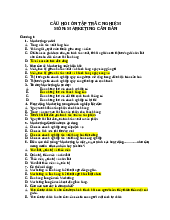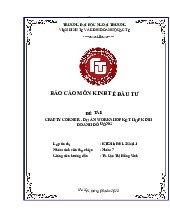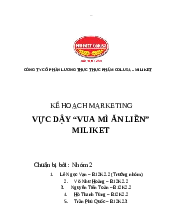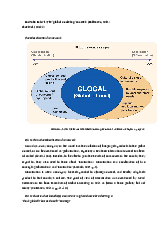






Preview text:
SHORT ANSWER QUESTIONS – MARKETING PRINCIPLES
Chapter 1: Marketing in a Changing World
1. Define marketing and discuss its role in the economy.
2. Compare the five marketing management philosophies.
3. Identify and discuss the major forces now changing the marketing landscape and
challenging marketing strategy.
4. Define and describe the marketing management concept.
5. Discuss the relationship between value, satisfaction and quality. Answer:
1. Marketing is a social and managerial process by which individuals and groups obtain
what they need and want through creating and exchanging products and values with
others. Economic roles include meeting needs, wants, and demands; creating products;
creating value and satisfaction; facilitating exchanges, transactions, and mutually beneficial
relationships; developing markets; meeting societal needs; increasing consumer choice; and providing fair profits.
2. Production Concept: Consumers favour products that are available and highly affordable.
Product Concept: Consumers favour products that offer the most value, the best
performance, and the largest number of innovative features.
Selling Concept: Consumers will not normally buy enough products on their own.
Marketing Concept: The successful company satisfies needs and wants more efficiently than its competitors do.
Societal Marketing Concept: The successful company determines customers' needs and
wants and society's best interests.
3. A growth in non-profit marketing seems to meet new needs. Rapid globalisation has
brought a geographic dispersion of purchasing, manufacturing, and marketing activities.
The changing world economy is marked by a decline in real buying power and an increase
in two-income households in the US. Increased demands for social responsibility require
more ethical business practices and more attention to the environmental consequences of
business decisions. Extremely rapid change is a feature of the new marketing landscape.
4. Marketing management is the analysis, planning, implementation, and control of
programs designed to create, build, and maintain beneficial exchanges with target buyers,
so as to achieve organisational objectives. Marketing management seeks to manage
demand efficiently and effectively, so as to help consumers obtain value in their
transactions while securing a profit for the company.
5. Customer value is the difference between the value the customer gains from owning and
using a product and the cost the customer incurs in obtaining the product. Satisfaction
depends on a product's perceived performance in delivering value relative to the buyer's
expectations. Quality, especially in the form of TQM, stems from a company's commitment
to constant improvement. Satisfaction comes from delighting and surprising customers with
more quality, thus heightening their perceived sense of value. Such practices are the only
formula for long-term success.
Chapter 2: Strategic Planning and the Marketing Process
1. Describe the strategic planning process. In your answer identify the four steps of strategic planning.
2. Describe, and compare and contrast, the BCG and GE portfolio matrix models. Also
discuss the limitations of portfolio analysis.
3. Describe the marketing management process and the forces that influence it.
4. Identify the sections of the marketing plan, taking care to describe both the strategic
function and the contents of each section.
5. Define the marketing implementation process. Explain how companies implement,
organize, and control their marketing efforts. Answer:
1. Strategic planning is defined as the process of developing and maintaining a strategic fit
between the organization's goals and capabilities and its changing marketing opportunities.
The four steps in the strategic planning process are the following: (1) defining the company
mission; (2) setting company objectives and goals; (3) designing the business portfolio; (4)
planning marketing and other related strategies.
2. The BCG consists of the following: Stars (high-growth, high-share); Cows (low-growth,
high-share); Question Marks (low-share, high-growth); Dogs (low-share, low-growth).
Strategies include building, holding, harvesting, and divesting. The GE Planning Grid has
two dimensions: industry attractiveness and business strength. Dimensions are an index
rather than a single measure. It is arguable that the BCG relies too much on market stare
while the GE Grid relies too much on formal planning.
3. The marketing management process involves helping each business unit of a company
reach its strategic objectives in relation to creating value for target consumers while
fulfilling company goals. Factors influencing this process are the target consumers (of
central importance), marketing mix decisions, planning, implementation, analysis and
control procedures, and micro- and macroenvironmental forces.
4. Marketing plans should have eight sections. The executive summary provides a brief
overview of key points. The current-marketing-situation section presents relevant
background. The threats-and-opportunities section identifies factors affecting the product.
The objectives-and-issues section defines share, profit, and sales goals. The marketing-
strategy section presents the broad approach. The action-programs section specifies how to
proceed. The budgets section gives profit-loss estimates. The controls section measures plan progress.
5. Marketing implementation turns strategies into plans and actions specifying who does
what, and where, when, and how. Marketing implementation requires an action program, an
organization structure, decision and reward systems, human resources planning, and an
appropriate fit with the company culture. Controls must provide objective feedback measures for all these areas.
Chapter 3: The Global Marketing Environment
1. Describe the environmental forces that affect the company's ability to serve its customers.
2. Explain the effect of changes in the demographic and economic environments on
marketing management decisions.
3. Identify the major trends in a firm's natural and technological environments.
4. Explain the key changes that occur in the political and cultural environments.
5. What is the significance of cultural values to marketers? Answer:
1. Companies are constrained by micro- and macroenvironmental forces. Microenvironmental forces include company departments, suppliers, marketing
intermediaries, customers, competitors, and various publics. Macroenvironmental
forces include demographic, economic, natural, technological,
political, and cultural forces.
2. The following changes in the demographic environment affect marketing decisions: the
changing age structure of the Canadian population, the changing Canadian family,
geographic shifts in population, the increase in educational attainment and white-collar
composition of the workforce, and increasing ethnic and racial diversity. Economic trends
include changes in income and income distribution, and changes in consumer spending patterns.
3. Trends in the natural environment include shortages of raw materials, increased cost of
energy, increased pollution, and government intervention in natural-resource management.
Trends in the technological environment include the fast pace of technological change, high
research-and-development budgets, concentration on minor improvements, and increased
regulation by government agencies.
4. Changes in the political environment include introduction of legislation regulating
business, changing government agency enforcement, and an increased emphasis on
publicly responsible action. Trends in the cultural environment include the persistence of
cultural values; shifts in secondary cultural values; and changes in people's views of
themselves, of others, of organisations, of society, of nature, and of the universe.
5. Marketers should remain alert to shifting cultural values in order to spot developing
threats or opportunities, and to help ensure that their marketing strategies reflect the
relevant culture's values. Cultural values may be reflected in the political-legal environment
and in the competitive environment. Firms that engage in international marketing may
have to learn how to deal with radically alien cultures.
Chapter 4: Marketing Research and Information Systems
1. Explain the importance of information to the company.
2. Define the marketing information system and discuss its parts.
3. Describe the four steps in the marketing research process.
4. Identify the different kinds of information a company might use.
5. Compare the advantages and disadvantages
of various methods of collecting information. Answer:
1. Marketing managers need timely, reliable, and relevant information in order to make
decisions that will enhance the company's ability to compete successfully in the
marketplace and increase customer value relative to the competition. Information, although
important, must be balanced between manager needs and what it is feasible to offer. Too
much information can overwhelm managers just as surely as too little information can lead to poor decisions.
2. A marketing information system (MIS) consists of people, equipment, and procedures to
serve marketing decision makers by gathering, sorting, analyzing, and distributing needed,
timely, and accurate information. The following are its four parts: components for the
developing of information; information system components; marketing managers; and the
marketing environment. The MIS links all these elements into a useable whole.
3. The following are the four steps in the marketing research process: defining the problem
and the research objectives; developing the research plan; implementing the research plan;
and interpreting and reporting the findings.
4. A company can use either secondary or primary data. Secondary data comprises
information that already exists, having been collected somewhere for some other purpose.
Primary data comprises information collected for the specific purpose at hand.
5. Advantages: Mail questionnaires facilitate collection of large amounts of information, at
low cost, from many households, without interview bias. Telephone work is best for quick
information collection, is flexible, provides sample control, and promises good response
rates. Personal interviews reach individuals or groups, are flexible, and offer tight focus.
Disadvantages: Mail is inflexible and offers low response rates. Telephone work is expensive
and suffers from interviewer bias. Personal interviews are expensive and typically present sampling problems.
Chapter 5: Consumer Markets and Consumer Buyer Behaviour
1. Define the consumer market and describe the elements of a simple model of buying
behaviour as identified in your text.
2. List and describe the major social factors that influence consumer buying behaviour.
3. Discuss the four major psychological factors that affect the buying process.
4. Identify and discuss the stages in the consumer adoption process for new products.
5. Identify and discuss the four types of behaviour associated with different types of buying situations. Answer:
1. The consumer market comprises all the final consumers of products and services. A
simple model of consumer behaviour uses the following headings: the "4 P's" (Product,
Place, Price, Promotion); "Environmental Forces"; the "Buyer's Black Box" (buyer
characteristics and buyer decision processes); and "Observable Choices" (decisions
regarding product, brand, dealer, purchase timing, and purchase amount).
2. Social factors include the influence of small groups, of family, and of social roles and
status. Groups can be defined by membership (whether primary or secondary), by
reference, or by aspiration. Opinion leaders exert influence within reference groups.
Family of orientation (parents) and procreation (spouse and children) also influence buying
behaviour. The term "roles" refers to socially expected activities, and "status" to the esteem
granted by society to the person performing in a given role.
3. Psychological factors include motivation, perception, learning, and beliefs and attitudes.
A motive is a drive sufficiently pressing to direct a person to seek satisfaction. Perception is
influenced by selective retention, attention, and distortion. Learning arises from changes in
behaviour due to experience, and occurs through the interplay of drives, stimuli, cues,
responses, and reinforcement. Beliefs are enduring descriptive attitudes.
4. The following are the stages in the new-product-adoption process: awareness, interest,
evaluation, trial, and adoption.
5. The following are four types of buying behaviour: complex buying behaviour, dissonance
buying behaviour, variety-seeking buying behaviour, and habitual buying behaviour.
Chapter 6: Business Markets and Business Buyer Behaviour
1. Explain how business markets differ from consumer markets.
2. Identify the major factors that influence business buyer behaviour.
3. List and define the stages in the business buying decision process.
4. Identify and discuss the three major types of buying situations.
5. Explain the unique aspects of how institutional and government buyers make their buying decisions. Answer:
1. Main differences include market structure and demand, nature of the buying unity, and
types of decisions and decision processes. Business markets are geographically
concentrated and have derived, inelastic, and fluctuating demand. Buying is more
professional and involves more people. Decisions are more professional and involve more
people. Decisions are more complex and more formalized; and in the decision process, the
buyer and seller are more dependent on each other.
2. There are four major influences. The following are environmental elements: level of
primary demand; economic outlook; cost of money; supply conditions; technological
change; political/regulatory change; and competitive developments. The following are
organizational elements: authority; status; empathy; and persuasiveness. The following are
individual elements: age; education; job position; personality; and attitudes toward risk.
3. Stages include problem recognition, general need description, product specification,
supplier search, proposal solicitation, supplier selection, order routine specification, and performance review.
4. A straight rebuy is a reorder without any modifications. A modified rebuy involves some
changes in product specifications, prices, terms, or suppliers. New-task buying occurs when
a company buys a product or service for the first time. In such cases, greater risk or cost
will lead to a larger number of decision participants, and to a greater effort in searching for information.
5. Institutional buyers include schools, hospitals, and prisons. Many institutions have low
budgets and captive patrons. Government buying may be coordinated by a special agency
and the buying process may be scrutinized by various publics. Governments may be
influenced by non-economic decision criteria. Government buying practices have various
potential drawbacks, including the following: they can be complex; they can entail
inordinate paperwork, bureaucracy, and regulation; and prices can be unattractively low.
Chapter 7: Market Segmentation, Targeting, and Positioning for Competitive Advantage
1. Define market segmentation, market targeting, and market positioning.
2. List and discuss the major basis for segmenting consumer and business markets.
3. Explain how companies identify attractive market segments and choose a market- coverage strategy.
4. Identify and discuss the four characteristics of effective market segmentation.
5. Explain how companies can position their products for maximum competitive advantage in the marketplace. Answer:
1. Market segmentation is the process of dividing a market into distinct groups of buyers
with different needs, characteristics, or behaviour who might require separate products or
marketing mixes. Market targeting involves evaluating each segment's attractiveness and
deciding which segments to enter. Market positioning is the setting of the competitive
position and the creation of a detailed marketing mix.
2. The major bases for segmenting consumer markets are geographic, demographic,
psychographic, and behavioural. The major bases for segmenting business markets are
demographics, operating variables, purchasing approaches, situational factors, and personal characteristics.
3. Segment attractiveness depends upon desirable segment size and growth, current and
potential competitors, threat of substitutes, power of buyers, and the power of suppliers.
Market coverage can include undifferentiated, differentiated, and concentrated strategies.
4. Market segments must have measurability (in terms of size, purchasing power, and clear
profiles), accessibility (can be effectively reached and served), substantiality (are
sufficiently large or profitable), and actionability (can design programs for attracting customers effectively).
5. Competitive advantage (Porter) offers consumers a superior value for the price.
Differentiation is the key to competitive advantage. A product's position is the view
customers have of its value. Positions can be differentiated by product attributes, services,
personnel, or image characteristics.
Chapter 8: Product and Services Strategies
1. Define PRODUCT and the major classifications of consumer and industrial products.
2. Describe the roles of product packaging and labelling.
3. Identify and discuss brand equity.
4. Define services and describe four characteristics that affect the marketing of a service.
5. Define and explain how persons are marketed. Answer:
1. A product is anything that can be offered to a market for attention, acquisition, use, or
consumption, and that might satisfy a want or need. Products can be classified as durable
goods, non-durable goods, and services. Consumer classifications include the following:
convenience, shopping, specialty, and unsought. The following are industrial classifications:
materials and parts, capital items, and supplies and services.
2. Packaging refers to the design and production of a container or wrapper for goods. The
packaging concept states what the package should be or do for the product. Packages in all
cases protect the product, and ideally serve the further function of promoting and
distinguishing it. Labelling in all cases identifies the product, and in many cases also
grades, describes, and promotes it.
3. Powerful brands have equity. Brand equity combines high brand awareness with brand
preference and loyalty, creating value in and of itself. The credibility of brand equity
becomes a marketable product commodity in its own right. Over time, brand equity can be
an enduring asset of a company, as it reliably provides continuing customer equity.
4. A service is any activity or benefit that one party can offer to another, provided that this
activity or benefit is essentially intangible and does not result in the ownership of anything.
The four characteristics of services are intangibility, inseparability, variability, and perishability.
5. Person marketing consists of activities undertaken to create, maintain, or change
attitudes or behaviour toward particular people. The objective of person marketing is to
create a celebrity whose name generates attention, interest, and action. Key aspects of
celebrity are durability life-cycle patterns ("standard," "overnight," "comeback," and
"meteor") and scope (the geographic range achieved).
Chapter 9: New Product Development and Life Cycle Strategies
1. List and define the steps in new product development.
2. Explain how companies find and develop new product ideas.
3. Identify and describe the stages of the product life cycle.
4. Explain how marketing strategy changes during a product's life cycle.
5. Distinguish between sequential product development and simultaneous product development processes. Answer:
1. Steps include idea generation, idea screening, concept development and testing,
marketing strategy development, business analysis, product development, test marketing,
and commercialization. Go/no-go decisions become more specific at each successive level.
2. Major sources of new product ideas include internal sources (such as sales-force and
other employees); customers; competitors; distributors and suppliers; and trends, including
broad societal trends, originating in the general public.
3. Stages in the product life cycle: development, introduction, growth, maturity, and decline.
4. As products are prepared for launch, marketers must choose initial positioning carefully.
Strategists, especially market pioneers, must choose between short-term and long-term
profits. During introduction, strategy focuses on awareness and acceptance of basic
product. Growth attracts competitors and more features. In maturity, strategy looks to
modifying the market, product, or mix. Decline forces a decision on continuing or discontinuing a weak product.
5. In sequential product development, each functional area of the company works on the
new product and passes its completed work on to the next division. In simultaneous
product development, each functional area provides ongoing (or "real-time" or "online")
feedback that is incorporated into the design, production, and marketing-planning stage.
Simultaneous design, although organizationally more complicated, reduces total
development and improves quality.




